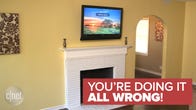CNET reader Ryan M. writes:
For a 64-inch plasma, how tall of a stand should I buy? I like this stand that’s 32″ off the ground (whereas most stands are 22″ off the ground). Do you think that if my line-of-sight is, say, 1/5 of the way up from the screen, I should be okay? I’d hate to have the stand be too tall.
TV height is an incredibly important issue, whether you’re using a stand or mounting the TV on the wall.
Your comfort is not usually the first thing you think of when setting up a TV. Probably not the second, either. But after you’ve got all the plugs plugged in and the settings set, every other interaction you’re going to have with the TV will involve sitting and watching. (Well, probably.) For most people, this is several hours a night. So viewer comfort should be a very high priority in your mind.
The key, other than minimizing reflections, is a comfortable viewing position. For nearly everyone, this means looking slightly down at the TV.
Now, most people aren’t going to position their TV low enough to stare down at it. Not least because it looks pretty weird in a room. So eye level (seated eye level, remember) is the next best thing.
It’s when you start putting it above eye level, so that you’re looking upward at the television, that there starts to be a problem. Think about your least favorite seats in a movie theater. The front few rows, right? Why? Because after the movie your neck is sore from staring up for 2 hours straight. Imagine that every time you watch TV.


Now playing:
Watch this:
Why a TV should never be mounted over a fireplace
1:01
Which is why I recommend NEVER mounting a TV above a fireplace. By far the worst place in a house to put a television. The heat and soot (if you use the fireplace) will ruin the electronics, and staring upward at the TV for hours on end will ruin your neck. A terrible idea.
As far as Ryan’s question goes, a tape measure and 10 minutes of research will help prevent future problems. Measure the height from the floor to the eyeballs of your seated viewing public. Mom and Dad for sure; kids optional. A few inches here and there won’t be a huge deal, so even if Mom’s 6-foot-1 and Dad’s 5-foot-2 you’ll at least have a range.
Now take what you know, like the height of the TV stand, and subtract that. For me, seated on my couch, my eyes are about 38 inches from the floor. So if I have a 22-inch TV stand, as long as the height of the TV from its base to the center of its screen is less than 16 inches, I’m all set.
Most TV manufacturers don’t publish this height specifically, but nearly all will give “Product Size Without Stand.” Dividing this height in half will get you roughly the center of the screen. For a 50-inch TV, this is around 14 inches. Excellent. For a 65-inch TV, we’re talking about 17 or 18 inches. Close enough.
Related stories
- LED LCD vs. plasma vs. LCD
- Active 3D vs. passive 3D: What’s better?
- How to set up an HDTV
- Why all HDMI cables are the same
- TV tech explainer: Every HDTV technology decoded
- TV weight: Fact and fiction
- Take a tour of Abbey Road Studios
There’s no set height you don’t want to go above. Personal preference, plus your actual couch, will have a lot to do with this. If you have a cushy couch that you lean back in (tilting your line of sight upward), then you can probably get away with putting the TV slightly higher. That is, as long as you always watch TV leaning back like that.
If you’re not sure, get a piece of tape, put it on the wall (or at the correct height on a stand), and stare at it for a bit. Not only will your family members be amused, but it will give you a solid idea of what it’s going to be like watching TV that way. If your thought is, “This will be OK, I think,” it won’t be. If after a few minutes there is any doubt, there is no doubt.
Remember, you’re going to be staring at the center of the screen almost all the time, so don’t assume that just because part of the screen is in range that it will work. A rule of thumb I just made up: keep the center third of the screen within the height range we discussed.
Got a question for Geoff? First, check out all the other articles he’s written on topics like HDMI cables, LED LCD vs. plasma, Active vs Passive 3D, and more. Still have a question? Send him an e-mail! He won’t tell you what TV to buy, but he might use your letter in a future article. You can also send him a message on Twitter @TechWriterGeoff or Google+.




